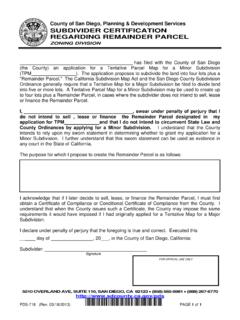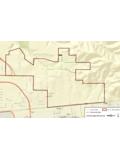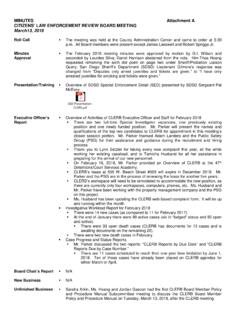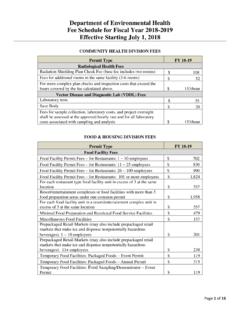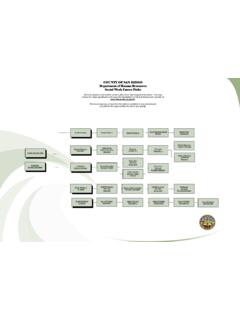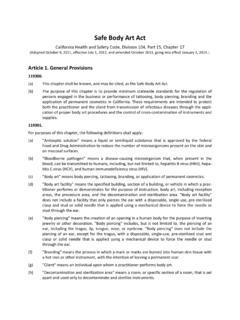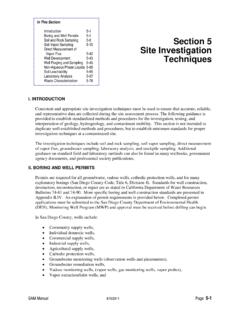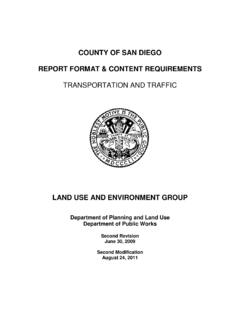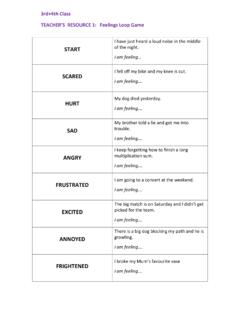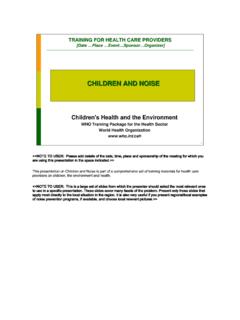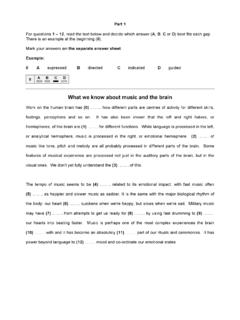Transcription of COUNTY OF SAN DIEGO GUIDELINES FOR …
1 COUNTY OF SAN DIEGO GUIDELINES FOR determining significance noise LAND USE AND ENVIRONMENT GROUP Department of Planning and Land Use Department of Public Works First Revision January 27, 2009 iii EXPLANATION These GUIDELINES for determining significance for noise and information presented herein shall be used by COUNTY staff for the review of discretionary projects and environmental documents pursuant to the California Environmental Quality Act (CEQA). These GUIDELINES present a range of quantitative, qualitative, and performance levels for particular environmental effects. Normally, (in the absence of substantial evidence to the contrary), an affirmative response to any one Guideline will mean the project will result in a significant effect, whereas effects that do not meet any of the GUIDELINES will normally be determined to be less than significant.
2 Section 15064(b) of the State CEQA GUIDELINES states: The determination whether a project may have a significant effect on the environment calls for careful judgment on the part of the public agency involved, based to the extent possible on factual and scientific data. An ironclad definition of significant effect is not always possible because the significance of an activity may vary with the setting. The intent of these GUIDELINES is to provide a consistent, objective and predictable evaluation of significant effects. These GUIDELINES are not binding on any decision-maker and do not substitute for the use of independent judgment to determine significance or the evaluation of evidence in the record. The COUNTY reserves the right to modify these GUIDELINES in the event of scientific discovery or alterations in factual data that may alter the common application of a Guideline. iv LIST OF PREPARERS AND TECHNICAL REVIEWERS FIRST REVISION January 27, 2009 COUNTY of San DIEGO noise Technical Review Panel Joe Farace, DPLU, Primary Author Jeff Fuller, Kimley-Horn John Bennett, DPLU, Contributing Author/ Technical Review Jeremy Louden, Urban Crossroads Charles Terry, Eilar Associates Emmet Aquino, DPLU Contributing Author/ Technical Review Bill Maddux, EDAW Kristen Koch, DPLU, Contributing Author Sami Real, DPLU, Contributing Author APPROVED MARCH 19, 2007 COUNTY of San DIEGO noise Technical Review Panel Joe Farace, DPLU, Primary Author Jeff Fuller, Kimley-Horn Eric Gibson, DPLU, Contributing Author Jeremy Louden, Urban Crossroads Jason Giffen, DPLU, Contributing Author Charles Terry, Eilar Associates John Bennett.
3 DPLU, Contributing Author/ Technical Review Bill Maddux, EDAW Emmet Aquino, DPLU Contributing Author/ Technical Review Devon Muto, DPLU, Technical Review v TABLE OF CONTENTS Section Page 1 Terms, General Principles, and 2 2 A-Weighted Sound Pressure Level (dB or dBA).. 2 Equivalent Sound Level (Leq).. 2 One-Hour Equivalent noise level (Leq(h)).. 2 Community noise Equivalent Level (CNEL).. 2 Day-Night Average Sound Level (DNL).. 3 noise Sensitive Land Use (NSLU).. 3 Impulsive 3 Maximum Sound Level (LMAX).. 3 General Principles and Existing 3 EXISTING REGULATIONS AND 4 Federal Regulations and 4 State Regulations and 5 Local Regulations and 6 TYPICAL ADVERSE 8 Construction 8 Operational 8 noise Sensitive Land Uses (NSLUs).
4 8 Exposure of noise Sensitive Avian 8 GUIDELINES FOR determining 9 noise Sensitive Land Uses Affected by Airborne 9 Project Generated Airborne 10 Groundborne Vibration and noise 13 Sources for 14 STANDARD MITIGATION AND PROJECT DESIGN 16 18 vi LIST OF FIGURES Figure Figure 1 San DIEGO COUNTY CNEL Contour Map .. 19 LIST OF TABLES Table Table 1 San DIEGO COUNTY Code Section , Sound Level Limits in Decibels (dBA).. 10 Table 2 San DIEGO COUNTY Code Section , Maximum Sound Level (Impulsive) Measure at Occupied Property in Decibels (dBA) .. 12 Table 3 San DIEGO COUNTY Code Section , Maximum Sound Level (Impulsive) Measure at Occupied Property in Decibels (dBA) for Public Road Projects .. 12 Table 4 Guideline for determining the significance of Ground-borne Vibration and noise Impacts.
5 13 Table 5 Guideline for determining the significance of Ground-borne Vibration and noise Impacts for Special 14 Table 6 Typical Mitigation Measures when significance GUIDELINES are ..17 LIST OF ATTACHMENTS Attachment Attachment A Sounds Levels Associated with Various noise Sources and Events .. 20 Attachment B Relationship between noise Exposure and Percentage of Community Highly Annoyed .. 21 Attachment C Screening Criteria for Potential Adverse Traffic noise 22 Attachment D Screening Criteria for Potential Adverse Ground-borne Vibration and noise Effects .. 23 Attachment E Summary of vii List of Acronyms ANSI American National Standards Institute CALTRANS California Department of Transportation CEQA California Environmental Quality Act CNEL Community noise Exposure Level dB Decibel dB re dB reference to DNL Day-Night Average Sound Level DPLU Department of Planning and Land Use VdB Vibration velocity level in decibels dBA A-weighted Sound Pressure Level FAA Federal Aviation Administration FHWA Federal Highway Administration HVAC Heating, Ventilation.
6 And Air Conditioning Hz Hertz ISO International Organization for Standardization Ldn Day-Night Average Sound Level Leq Equivalent Sound Level Leq(h) One-Hour Equivalent noise Level LMAX Maximum Sound Level NSLU noise Sensitive Land Use rms Root mean square sec Second GUIDELINES for determining significance for 1 noise INTRODUCTION This document provides guidance for evaluating any substantial environmental effects that a proposed project may have from noise . Specifically, this document aids in addressing the following questions listed in the California Environmental Quality Act (CEQA) GUIDELINES , Appendix G, XI.
7 noise : Would the project: a) Result in exposure of persons to or generation of noise levels in excess of standards established in the local general plan or noise ordinance, or applicable standards of other agencies? b) Result in exposure of persons to or generation of excessive ground borne vibration or ground borne noise levels? c) Result in a substantial permanent increase in ambient noise levels in the project vicinity above levels existing without the project? d) Result in a substantial temporary1 or periodic increase in ambient noise levels in the project vicinity above levels existing without the project? e) For a project located within an airport land use plan or, where such a plan has not been adopted, within two miles of a public airport or public use airport, would the project expose people residing or working in the project area to excessive noise levels? f) For a project within the vicinity of a private airstrip, would the project expose people residing or working in the project area to excessive noise levels?
8 Depending on intensity, frequency, duration and other factors, noise can affect human health and quality of life. noise problems can manifest themselves in two general ways: The absolute level of noise can generate impacts to existing or reasonably forseeable future noise sensitive land uses; or A substantial increase to the ambient noise levels existing before project implementation can generate impacts to preexisting noise sensitive land uses. 1 Temporary For purposes of materials handling and impact equipment noise assessments, "temporary" is defined as one month of operation, or 240 hours, within 3 consecutive calendar months. Any material handling or impact equipment in continuous operation longer than this period may be considered an operation and would no longer be covered under the noise construction ordinance. Evaluation of construction work is dependent on the project site and its situation ( , fixed or mobile sources, proximity to other land uses, and type of noise source).
9 GUIDELINES for determining significance for 2 noise There are a number of noise level standards in existing Federal, State, and local regulations. The COUNTY of San DIEGO has two principal noise regulations, the noise Element of the General Plan and the noise Ordinance. The noise Element of the General Plan establishes sound level limits for noise received at noise sensitive land uses. It identifies the major sources of noise to be airports and traffic on public roadways. The noise Ordinance establishes sound level limits for noise sources. In addition, there are other Federal, State and local regulations that address airport and federally funded highway noise . TERMS, GENERAL PRINCIPLES, AND EXISTING CONDITIONS Terms Environmental noise is comprised of infinite combinations of sound intensities of varying frequency and duration. In order to reasonably characterize environmental noise the following weighted and averaging terms are utilized: A-weighted Sound Pressure Level (dB or dBA) Some frequencies of noise are more noticeable than others.
10 To compensate for this fact, different sound frequencies are weighted more heavily (A-weighted) so that the response of the average human ear is simulated. Equivalent Sound Level (Leq) Environmental noise often fluctuates over time. To be able to describe this in a practicable manner the Leq was developed. Leq is the A-weighted steady sound level that contains the same total acoustical energy as the actual fluctuating sound level. One-Hour Equivalent noise Level (Leq(h)) A one-hour equivalent noise level is a measurement of noise intensity, which is the equivalent sound level (Leq) over a one hour averaging period. Community noise Equivalent Level (CNEL) This term applies weights to noise during evening and nighttime hours to compensate for the increased sensitivity of people to noise at those times. CNEL is the equivalent sound level for a 24-hour period with a +5 dB weighting applied to all sound occurring between 7:00 and 10:00 and a +10 dB weighting applied to all sound occurring between 10:00 and 7:00 CNEL is expressed in the A-weighting frequency scale.
